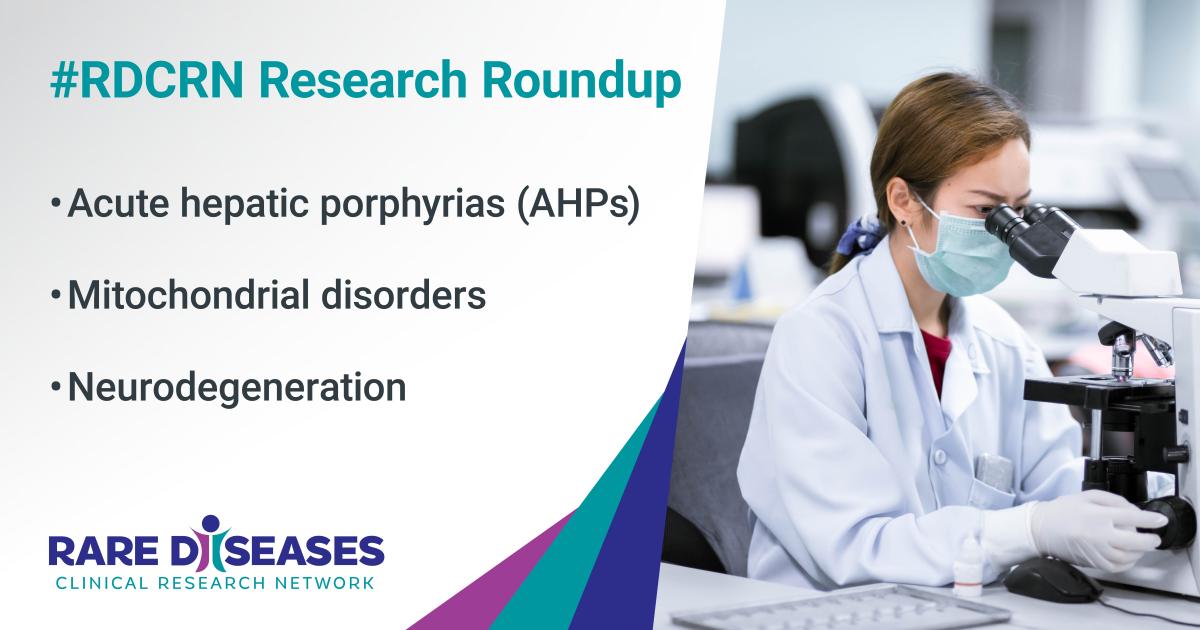Each week, we share summaries of recent Rare Diseases Clinical Research Network (RDCRN) grant-funded publications. Read new research on acute hepatic porphyrias (AHPs), mitochondrial disorders, and neurodegeneration.
Predicting Drugs and Chemicals that May Induce Porphyric Attacks in Patients with Acute Hepatic Porphyrias
Porphyrias Consortium (PC): Assessment of porphyrogenicity of drugs and chemicals in selected hepatic cell culture models through a fluorescence-based screening assay
Acute hepatic porphyrias (AHPs)—including ALA dehydratase deficiency porphyria, acute intermittent porphyria, hereditary coproporphyria, and variegate porphyria—are a subtype of porphyrias classified as having a hepatic (liver) origin. In patients with AHPs, some drugs and chemicals may trigger or exacerbate acute porphyric attacks. However, there is currently no standard model to assess and predict the likelihood of drugs and chemicals to induce these attacks.
In this study, researchers aimed to develop a fluorescence-based in vitro assay for this purpose. The team studied four different hepatic cell culture models. They found that LMH cell cultures in multi-well plates are an inexpensive, robust, and simple system to predict the porphyrogenicity of compounds that may exacerbate the AHPs.
Expanding the Spectrum of NFS1-Related Mitochondrial Disorders
North American Mitochondrial Disease Consortium (NAMDC): Expanding the phenotypic and molecular spectrum of NFS1-related disorders that cause functional deficiencies in mitochondrial and cytosolic iron-sulfur cluster containing enzymes
Iron-sulfur cluster proteins play critical roles in gene expression regulation and mitochondrial processes, including oxidative phosphorylation (the process by which mitochondria produce energy that the body can use). Previously, a variant in the NFS1 gene has been reported to cause infantile mitochondrial complex II and III deficiencies, which are protein complex defects that disrupt oxidative phosphorylation.
In this study, researchers describe three new, unrelated patients; two were homozygous for the same p.Arg72Gln variant, while the third with a milder phenotype had the same variant in compound heterozygosity with a novel p.Arg412His. Their findings expand the phenotypic spectrum of NFS1-related disorders. Authors note that this study provides further evidence for the pathogenicity (disease-causing) and functional sequelae (after-effects) of NFS1-related disorders that cause functional deficiencies in both mitochondrial and cytosolic iron–sulfur cluster containing enzymes.
Novel Biallelic NRROS Variants Associated with Severe Neurodegeneration
Global Leukodystrophy Initiative Clinical Trials Network (GLIA-CTN): Novel biallelic variants in NRROS associated with a lethal microgliopathy, brain calcifications, and neurodegeneration
The protein NRROS (negative regulator of reactive oxygen species) is expressed by microglia (immune cells of the central nervous system) and perivascular macrophages (brain macrophages, or immune cells, characterized by a close association with the cerebral vasculature). To date, 9 individuals have been reported with biallelic (affecting both alleles of a gene) NRROS variants.
In this study, researchers used exome sequencing to identify 2 novel NRROS variants—a missense variant and a premature stop codon—in an individual with a severe neurodegenerative phenotype. Through pathological examination, they found both extensive grey and white matter involvement, dystrophic calcifications, and infiltration of foamy macrophages.
Authors state that this is the first reported case of NRROS variants with a mitochondrial ultrastructure abnormality noted on electron microscopy analysis of post-mortem tissue.
The Rare Diseases Clinical Research Network (RDCRN) is funded by the National Institutes of Health (NIH) and led by the National Center for Advancing Translational Sciences (NCATS) through its Division of Rare Diseases Research Innovation (DRDRI). Now in its fourth five-year funding cycle, RDCRN is a partnership with funding and programmatic support provided by Institutes, Centers, and Offices across NIH, including the National Institute of Neurological Disorders and Stroke, the National Institute of Allergy and Infectious Diseases, the National Institute of Diabetes and Digestive and Kidney Diseases, the Eunice Kennedy Shriver National Institute of Child Health and Human Development, the National Institute of Arthritis and Musculoskeletal and Skin Diseases, the National Heart, Lung, and Blood Institute, the National Institute of Dental and Craniofacial Research, the National Institute of Mental Health, and the Office of Dietary Supplements.






